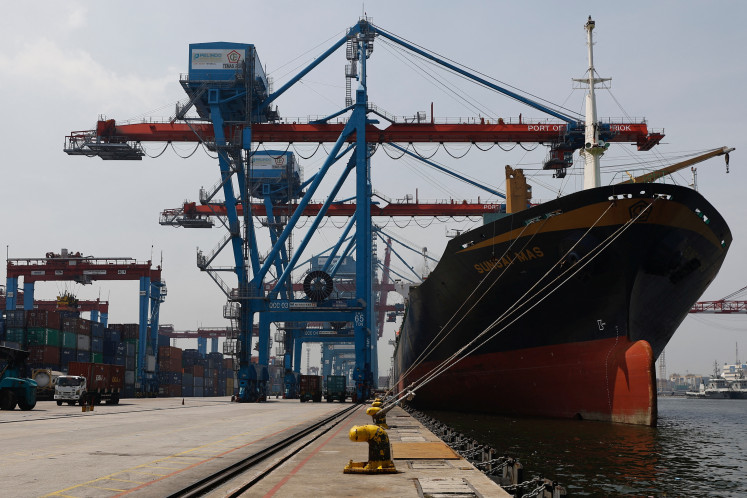Mapping borders, providing certainties
In October, a new province was officially established in Indonesia, making it the 34th province in the archipelago
Change text size
Gift Premium Articles
to Anyone

I
n October, a new province was officially established in Indonesia, making it the 34th province in the archipelago. The new province is North Kalimantan, which was previously part of East Kalimantan.
In addition to the new province, a number of new regencies/cities were also established.
Consequently, the number of local governments in Indonesia is growing. Indonesia now has more governors and regents/mayors for its newly established regions. One important consequence of the establishment of new regions is the need for regional boundaries to be settled.
In Borneo, a new inter-provincial boundary is now required, separating the newly established North Kalimantan from East Kalimantan. Likewise, the establishment of new regencies/cities also requires boundary settlements. In the early 1990s, Goenawan Mohammad, a senior editor with Tempo weekly, wrote in his famous “Catatan Pinggir” that God might not agree to the world map that men had created.
In his argument, Goenawan stated that the map kept on changing especially when it came to lines depicting boundaries between countries or regions. It seems that this argument is still valid.
The establishment of North Kalimantan and other regions in Indonesia will eventually change Indonesia’s official map. New lines need to be drawn between East Kalimantan and North Kalimantan. In the case of North Kalimantan, a new border emerges.
On the other hand, the fusion of two countries or regions also changes the appearance of the world map. The fall of the Berlin Wall in 1989, for example, marked the unification of East and West Germany.
History has recorded that one of the strongest symbols of separation, the Berlin Wall, eventually fell when politics changed and when people insisted on making the change a reality. In the case of Germany, borders disappeared and it consequently changed the map of the world.
In such a big world, which human eyes cannot cover, the need of visual representation is essential. A map is necessary to represent the world, including the borders between countries and regions.
A map also serves as a legal document depicting boundaries, the demarcation of which in the real world might be inadequate in terms of density. Put simply, maps are important when it comes to the establishment and maintenance of boundaries.
The establishment of new regions in a country like Indonesia is an essentially political process conducted by the legislature and government (executive). Officially, a new region is established through a promulgation of the Region Establishment Law (UUPD).
One important technical aspect in the establishment of regions is the creation of a map attached to the UUPD. Such a map accompanies the law and becomes an important supporting document that legally completes/supplements the law.
A map attached to the UUPD depicts the delimitation of boundaries between regions. This then serves as a legal basis for demarcation. In this case, “delimitation” is a boundary established on a map based on a political agreement, while “demarcation” is an activity to mark such a boundary in the real world.
While delimitation involves activities to draw lines on a map, demarcation requires pillars and monuments to be erected in the field, based on boundaries depicted on the map. Consequently, accurate maps attached to the UUPD are essential to facilitate the demarcation process.
Maps attached to the UUPD should satisfy certain technical criteria so that they can be used as guides for the demarcation process. Researchers in the department of geodetic engineering at Gadjah Mada University have conducted reasonably comprehensive research to investigate the quality of maps attached to the UUPD.
The purpose of the research is to analyze whether or not the maps can be used as a basis for demarcation. Interestingly, a significant percentage of these maps were considered insubstantial for demarcation.
This article is not, however, a comprehensive report of the research, as that is due to be published in a scholarly journal in the near future.
If adequate maps are not available, proper boundary demarcation cannot be carried out. Demarcation is essentially transferring the coordinates of points and lines from a map to the field.
When technical aspects of a map such as scale, map projection, geodetic datum and coordinate system are unclear or below standard, the map is ineligible for boundary demarcation.
If a demarcation process is implemented by utilizing such a map, such a demarcation is likely to produce inaccurate positions for boundary pillars and monuments, which will eventually generate problems in boundary management. For instance, it is closely related to the rights and responsibilities of neighboring parties in relation to resource utilization.
For a newly established region such as North Kalimantan and other potential regions in the future, it is important to ensure that a map attached to its UUPD meet all the criteria so as to be used in demarcation. Otherwise, boundary demarcation cannot be completed.
For those already established regions with inadequate maps attached to the UUPD, revision is required. The relevant parties need to go through all the processes and ensure that the maps are reproduced to a new standard to allow for demarcation.
To sum up, accurate maps are essential in defining boundaries in relation to the establishment of new regions. They serve as the necessary starting point for good boundary demarcation.
At the end of the day, boundaries are not merely about erecting pillars and monuments. They include administrative and management activities to ensure that the boundaries provide certainties and contribute positively toward the promotion of people’s welfare along and across the borders.
The writer is a lecturer at the department of geodetic engineering, Gadjah Mada University. He is currently an
Alison Sudradjat Award Scholar at the Australian National Center for Ocean Resources and Security, University of Wollongong









